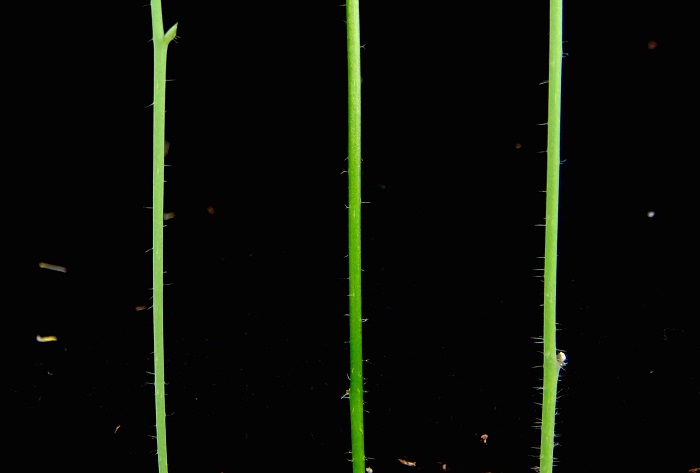
Article by Tegan Haslam (Kunst Lab)
The transition of plants to life on land required many adaptations for survival in an environment so radically different from the sea. Perhaps the most challenging aspect of terrestrial life is the necessity of retaining water, which makes up more than 70% of most non-woody plant parts. Plants have many tools to address this challenge: stomatal pores that regulate gas exchange and water vapor loss, a complex vasculature for transporting water throughout the plant, and a waxy cuticle which serves as a barrier on all primary, aerial surfaces, preventing direct transpiration out of plant cells into the environment.
Our lab uses molecular genetics to study the synthesis and secretion of cuticular wax. Cuticular wax is a unique feature of land plants, as are the biochemical pathways and enzymes which make wax. However, the synthesis of cuticular wax builds off of fatty acid metabolism, which is ubiquitous in life. We are interested in the first steps in wax metabolism in which fatty acids are elongated to exceptional lengths suitable for conversion to waxes. These 28-34 carbon fatty acids and their derivatives make an excellent water barrier on the plant surface as they are very hydrophobic and are solid at room temperature. Given these physical properties, it is not surprising that the elongation of fatty acids to exceptional lengths requires tight regulation and biochemical machinery distinct from that used to make fatty acids for the synthesis of primary metabolites like membrane and storage lipids.

We are characterizing a new protein family called CER2-LIKEs. CER2 and its homologs modulate the chain length specificity of the core fatty acid elongation machinery, and enable it to produce the 28-36 carbon-long fatty acids required for wax biosynthesis. The core elongase is used for the production of all fatty acids, from 16-36 carbons, but CER2-LIKEs only appear to play a role in the elongation of fatty acids longer than 28 carbons. Accordingly, CER2-LIKEs are unique to cuticle-bearing land plants, and are a sub-group of the plant-specific enzyme family of BAHD acyltransferases. Despite homology to BAHDs, we found that mutagenesis of the putative acyltransferase catalytic site of CER2 does not compromise its function. Therefore, CER2 must have different biochemical activity from that described for the BAHD acyltransferase family.
We have developed a biochemical assay in yeast to observe and dissect the activity of CER2-LIKEs, and have demonstrated that a CER2-LIKE with the core elongation machinery is all that is necessary and sufficient to make exceptionally long wax precursors. Moreover, different CER2-LIKE proteins impart different specificities; for example, CER2 enables elongation to 30 carbons, and CER2-LIKE1 enables elongation to 34 carbons. These subtle changes in chain length have important consequences for the structure and physical properties of the cuticle.
The biochemical function of CER2-LIKEs remains unknown, but our studies suggest that these proteins do not have catalytic activity. Based on our yeast assay and protein-protein interaction data, our best hypothesis is that CER2-LIKEs function as allosteric modifiers of ubiquitous components of the elongase machinery called condensing enzymes. In the absence of CER2-LIKEs, condensing enzymes determine specificity of the elongase, so it fits that interaction between CER2-LIKEs and condensing enzymes could jointly establish unique specificity during wax production. To elucidate this process, we are carrying out protein domain swaps, further protein-protein interaction experiments, and tertiary structure modeling focused on CER2 and condensing enzymes.
While there are other organisms that can make fatty acids up to 36 carbons and longer, the pathway plants use to make cuticular waxes is unique, as are CER2-LIKEs and their apparent effects on condensing enzyme specificity. Determining how CER2-LIKEs function is an important step towards understanding the metabolic adaptations of plants to their dry, terrestrial environment.
Figure 1: Water beading off tepals of a lily, which is a consequence of repulsion between water and the hydrophobic cuticle.
Figure 2: Cuticular wax morphology can make plant surfaces appear whitish and dull. The stem on the left is from a wild-type Arabidopsis plant, while the glossy green stem in the middle is a cer2 mutant, which has compromised wax biosynthesis and altered wax crystal structure. The plant on the right is the cer2 mutant complemented with a CER2 transgene, demonstrating that the lesion in the CER2 gene is responsible for the wax-deficient phenotype of the cer2 mutant.